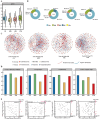Research on soil bacterial community assembly and function under different straw returning practices in arid and semi-arid agricultural ecosystems over multiple years
- PMID: 40421462
- PMCID: PMC12104234
- DOI: 10.3389/fmicb.2025.1590686
Research on soil bacterial community assembly and function under different straw returning practices in arid and semi-arid agricultural ecosystems over multiple years
Abstract
Introduction: Straw return has gained attention for its potential to improve soil quality and crop yields, particularly in semi-arid regions like the Tumu Chuan Plain Irrigation Area. Soil bacteria play a crucial role in regulating soil biological processes, and understanding how straw return affects bacterial populations can guide better agricultural management practices.
Methods: We investigated the impact of continuous straw return on soil bacterial communities using 16S rRNA gene sequencing. Four treatments were applied: Farmers' shallow rotation (CK), straw incorporated with deep tillage (DPR), straw incorporated with subsoiling (SSR), and no-tillage mulching straw return (NTR). Bacterial community structure, metabolic pathways, and assembly mechanisms were analyzed using Bugbase and PICRUSt2 for phenotypic and metabolic pathway predictions.
Results: The study found that straw return practices significantly altered the relative abundance and life history strategies of bacterial phyla, mainly influenced by soil organic matter (SOM) and enzyme activity. The K-strategist to r-strategist ratio was highest in CK (2.06) and lowest in SSR (1.89). DPR and NTR treatments significantly changed bacterial community structure compared to CK (p < 0.05), resembling SSR. Predictions showed that DPR and NTR enhanced carbohydrate and amino acid metabolism and promoted more stable bacterial networks, with homogenous selection and drift effects. Bacterial aggregation in all treatments was driven by random processes, with varying aggregation levels: CK (20%), DPR (38.6%), SSR (16.5%), and NTR (30.7%).
Discussion: The study demonstrates that continuous straw return practices significantly impact soil bacterial communities. DPR and NTR notably improved microbial diversity, bacterial cooperation, and ecosystem stability. These findings provide valuable insights for sustainable agricultural practices in semi-arid regions, enhancing soil microbial ecology and soil health through strategic straw return.
Keywords: bacterial lifestyle; ecosystem stability; semi-arid agriculture; soil microbial community assembly; straw return practices.
Copyright © 2025 Liu, Zhao, Feng, Zhao, Li, Yu, Hu, Li, Gao and Borjigin.
Conflict of interest statement
The authors declare that the research was conducted in the absence of any commercial or financial relationships that could be construed as a potential conflict of interest.
Figures




Similar articles
-
Effects of different straw return methods on soil properties and yield potential of maize.Sci Rep. 2024 Nov 19;14(1):28682. doi: 10.1038/s41598-024-70404-8. Sci Rep. 2024. PMID: 39562621 Free PMC article.
-
The long-term straw return resulted in significant differences in soil microbial community composition and community assembly processes between wheat and rice.Front Microbiol. 2025 Feb 27;16:1533839. doi: 10.3389/fmicb.2025.1533839. eCollection 2025. Front Microbiol. 2025. PMID: 40083788 Free PMC article.
-
Long-term effects of maize straw return and manure on the microbial community in cinnamon soil in Northern China using 16S rRNA sequencing.PLoS One. 2021 Apr 22;16(4):e0249884. doi: 10.1371/journal.pone.0249884. eCollection 2021. PLoS One. 2021. PMID: 33886593 Free PMC article.
-
Impact of tillage practices on soil bacterial diversity and composition under the tobacco-rice rotation in China.J Microbiol. 2017 May;55(5):349-356. doi: 10.1007/s12275-017-6242-9. Epub 2017 Mar 1. J Microbiol. 2017. PMID: 28251545
-
Impact of straw returning on soil ecology and crop yield: A review.Heliyon. 2025 Jan 3;11(2):e41651. doi: 10.1016/j.heliyon.2025.e41651. eCollection 2025 Jan 30. Heliyon. 2025. PMID: 39882467 Free PMC article. Review.
References
-
- Allen S. E., Grimshaw H. M. (1986). Methods of soil analysis, part 2: chemical and microbiological properties. Madison, WI: American Society of Agronomy.
-
- Bernardino P. N., de Keersmaecker W., Horion S., Oehmcke S., Gieseke F., Fensholt R., et al. . (2025). Predictability of abrupt shifts in dryland ecosystem functioning. Nat. Clim. Change 15, 86–91. doi: 10.1038/s41558-024-02201-0 - DOI
-
- Bremner J. M. (1960). Determination of nitrogen in soil by the kjeldahl method. Journal of Agricultural Science. 55, 11–33. doi: 10.1017/S0021859600021572 - DOI
LinkOut - more resources
Full Text Sources
Research Materials

